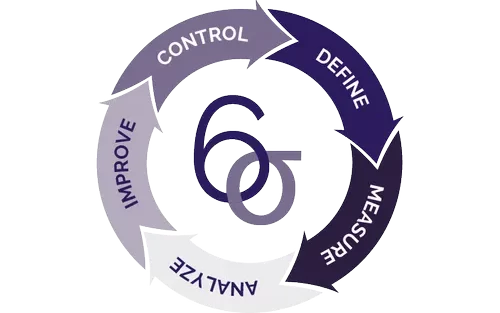
In the world of business, the pursuit of excellence is a journey rather than a destination. Organizations that strive for operational excellence continuously seek ways to optimize processes, enhance quality, reduce costs, and improve overall efficiency. To embark on this transformative journey, many businesses are turning to the dynamic integration of Six Sigma and Lean Management—a powerful duo that has the potential to reshape their operations and drive business transformation.
Understanding the Synergy
At its core, Six Sigma is a data-driven methodology that focuses on reducing process variations and eliminating defects. In contrast, Lean Management is centered on eliminating waste and enhancing process efficiency. When these two methodologies are seamlessly integrated, they create a holistic framework for continuous improvement, combining the precision of Six Sigma with the simplicity and speed of Lean Management.
Reducing Waste: Lean Principles at Play
Lean principles are like the scalpel of process optimization. They dissect processes to identify and eliminate various forms of waste, such as overproduction, excess inventory, waiting time, and unnecessary motion. By optimizing workflows, Lean Management aims to make processes more efficient, reducing both time and resource waste.
The Benefits of six sigma
The integration of Six Sigma and Lean Management offers numerous advantages, including:
- Waste Reduction: Lean principles identify and eliminate various forms of waste, such as overproduction, inventory, and waiting time, leading to more efficient processes.
- Cost Savings: By streamlining operations, reducing defects, and minimizing waste, organizations can significantly cut operational costs.
- Quality Enhancement: Six Sigma’s data-driven approach ensures consistent quality, while Lean Management reduces errors and rework.
- Faster Processes: Lean principles optimize workflows and reduce lead times, allowing organizations to respond more quickly to customer demands.
- Employee Engagement: Both methodologies emphasize the importance of engaging employees in continuous improvement efforts, fostering a culture of excellence.
The DMAIC Framework of six sigma
At the heart of Six Sigma is the DMAIC framework—Define, Measure, Analyze, Improve, Control. This structured approach to problem-solving and process improvement aligns seamlessly with Lean principles, making it a cornerstone of the integrated approach.
- Define: Clearly articulate the problem, project goals, and customer requirements. This phase sets the foundation for the improvement project.
- Measure: Gather data and assess the current state of the process to identify opportunities for improvement. Lean principles come into play here to identify waste.
- Analyze: Use data analysis to identify the root causes of defects, variations, or inefficiencies in the process.
- Improve: Develop and implement solutions to address the root causes, often by eliminating waste and optimizing the process.
- Control: Establish control mechanisms to sustain the growth and prevent the process from regressing.
Real-World Success Stories
Real-world success stories illustrate the tangible benefits of this integration, from manufacturing plants to healthcare facilities and beyond. Companies that have embraced Six Sigma and Lean Management integration have seen reduced defects, enhanced efficiency, and improved customer satisfaction, ultimately achieving operational excellence. Consider the following examples:
- A manufacturing company reduced defects in its production line by 40%, resulting in substantial cost savings.
- A healthcare provider improved patient wait times and reduced errors, leading to higher patient satisfaction scores.
- An e-commerce business streamlined its order processing system, resulting in faster delivery times
As organizations look to the future, the integrated approach of Six Sigma and Lean Management remains adaptable and resilient. It enables businesses to not only navigate change but also innovate and stay competitive in dynamic markets.
the integration of Six Sigma and Lean Management is more than a methodology; it’s a strategic decision to transform businesses into leaner, more efficient, and customer-centric enterprises. It’s a commitment to excellence, a pursuit of continuous improvement, and a roadmap to sustainable success in an ever-evolving business landscape. By harnessing the power of integration, organizations can embark on a transformative journey towards operational excellence.
Six Sigma Tools for Improving Quality
.DMAIC: Definition, Measurement, Analysis, and Improving Control This plan must include using this data-driven template to enhance current procedures.
5s: Sort, Straighten, Shine, Standardise, and Sustain are the acronyms for this tool. This is a fantastic approach to streamline and simplify your office. On the most fundamental level, waste is eliminated using this.
Wastes: 7 Inventory, Motion, Overprocessing, Overproduction, Waiting, Transport, and Defects are examples of non-value-added losses.
Value Stream Mapping: Given that it enables you to visually see the entire process from beginning to end, this Lean Six Sigma tool and approach may be the most crucial. It also depicts how value should flow once improvements have been made in the future.
Does Six Sigma Make Sense for Your Business?
Since the suitability of Six Sigma will differ from company to company depending on criteria such as the firm’s size, industry, and special needs, there is no universally applicable solution to this question. However, the following general advice could assist in deciding whether Six Sigma is appropriate for a company:
1.determining whether the business actually needs to improve. Since Six Sigma is intended to assist organisations in improving their performance, it might not be the ideal option if there are no areas that need to be improved.
2.assessing the company’s ability to apply Six Sigma and its resources. Before starting a Six Sigma project, businesses must make sure they have the appropriate personnel and financial resources. Six Sigma can be a resource-intensive undertaking.
3.assessing the readiness of the organisation for the change that Six Sigma will bring. Before implementing Six Sigma, it is crucial to make sure that the business is ready for the shift because Six Sigma can be a big change for an organisation.
Conclusion
The Six Sigma methodology is a well-known and popular process improvement approach in many industries. Its popularity is due in part to its proven track record of success in improving process quality and efficiency.The Six Sigma approach can be adapted to many operations and business processes. When implemented correctly, it can significantly improve quality and productivity.

